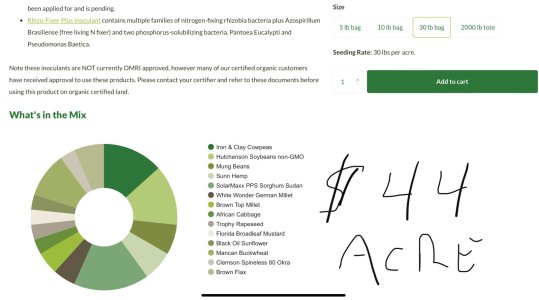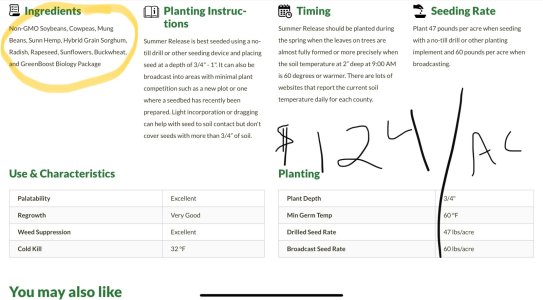It's easy to get caught up in the wonder of super diversity and forget to get back to intentionality with what we're doing.
I see lots of stuff in blends that I either know deer won't eat, or have no idea if they'll eat it.
Before anyone buys a blend, or makes a blend, they should understand why what is in there, is in there. If there's no reason for it, it's just taking up space from something else that was going to do something useful. My blends usually consist of a primary blend of 3-5 species, and then I whip up a hot cocktail of low probability / high rate wild cards.
This is where I throw in wild flowers, flax, plantain, japanese millet, carrots, pumpkins, squash, etc. For example, a pound of carrot seed will get you 288,000 seeds for $30. I'll split that between two acres to see what happens. It'd be kinda funny to see even a 1% take rate and have a few thousand carrots coming up in a one acre plot. Carrots never worked, but black eyed susan came in like gang busters. Still waiting to see if purple coneflower ever made it. This will be year 3 after a fall planting, and I've planted them every year since that.
Seed blenders have a hard task ahead of themselves trying to compete in a business where many are just repacking stuff we could get ourselves and without their markup and fancy jargon on social media. I won't take away from those that do provide value though. Some is in the logistics, some in in simplicity for the busy folks, some is in rarity. I like Green cover because I can get 1 and 5 lb bags of pure and individual seeds I can't get elsewhere. I like Albert Lea because they carry certain grains I can't get anywhere else. I like Milborn Seed In South Dakota because I can call in my order when I'm flying by and get everything I want at ag prices. I like Outside pride because they also carry harder to get single seeds when others may be out.
I like to complicate it. Gotta get the biggest punch out of the space I have, with the time I have, and I don't wanna blow any more $$ than necessary.

